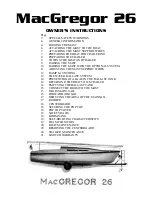
4
Make sure your drain plug is secure.
Passengers should always wear a Personal Flotation Device.
Check for wind conditions, currents or wave conditions that would make it difficult to paddle back.
Always let someone know of your boating plans, your boating location, and when you expect to return.
CARE AND MAINTENANCE
Your kayak is designed to require minimal maintenance, and a little timely care will ensure a lifetime of enjoyment. Whenever you
wash your boat, use mild soap and water. Rinse your boat and hardware thoroughly after paddling in salt, brackish or polluted water.
A quick rinse of the moving parts of the foot braces keeps them clean and operating smoothly.
Occasional operational checkups will keep your boat in tip top condition. Check hatch covers, cables, buckles, straps and other
moving parts for wear, and replace them when necessary. Give your hull and deck a thorough review annually. Light nicks,
scratches and scrapes are part of the paddling experiences, but deep scratches should be repaired.
Polyethylene is a somewhat flexible material with some memory. This means it has a tendency to return to its original molded
shape if distorted. If this occurs, follow these steps:
1. Relieve the pressure that caused the dent or distortion by supporting the boat differently or removing the gear.
2. Place the boat in the warm sun. Usually the south side of the building is the warmest spot. As the boat warms up, usually
(but not always) the boat will return to its original molded shape. This may take a few hours or a couple of weeks depending
upon outside temperatures and the degree of distortion.






























